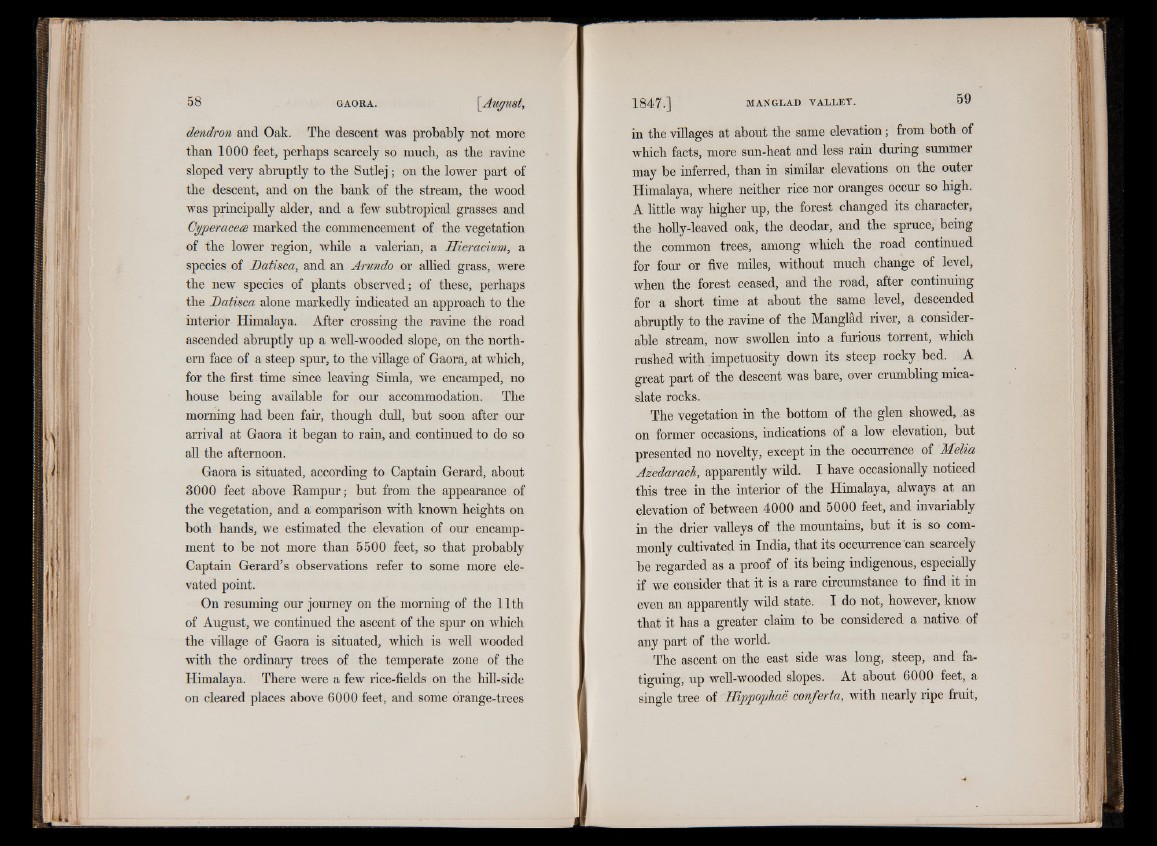
dendron and Oak. The descent was probably not more
than 1000 feet, perhaps scarcely so much, as the ravine
sloped very abruptly to the Sutlej; on the lower part of
the descent, and on the bank of the stream, the wood
was principally alder, and a few subtropical grasses and
Cyperaceae marked the commencement of the vegetation
of the lower region, while a valerian, a Hieracium, a
species of Datisca, and an Arundo or allied grass, were
the new species of plants observed; of these, perhaps
the Datisca alone markedly indicated an approach to the
interior Himalaya. After crossing the ravine the road
ascended abruptly up a well-wooded slope, on the northern
face of a steep spur, to the village of Gaora, at which,
for the first time since leaving Simla, we encamped, no
house being available for our accommodation. The
morning had been fair, though dull, but soon after our
arrival at Gaora it began to rain, and continued to do so
all the afternoon.
Gaora is situated, according to Captain Gerard, about
3000 feet above Rampur; but from the appearance of
the vegetation, and a comparison with known heights on
both hands, we estimated the elevation of our encampment
to be not more than 5500 feet, so that probably
Captain Gerard’s observations refer to some more elevated
point.
On resuming our journey on the morning of the 11th
of August, we continued the ascent of the spur on which
the village of Gaora is situated, which is well wooded
with the ordinary trees of the temperate zone of the
Himalaya. There were a few rice-fields on the hill-side
on cleared places above 6000 feet, and some orange-trees
in the villages at about the same elevation; from both of
which facts, more sun-heat and less rain during summer
may be inferred, than in similar elevations on the outer
Himalaya, where neither rice nor oranges occur so high.
A little way higher up, the forest changed its character,
the holly-leaved oak, the deodar, and the spruce, being
the common trees, among which the road continued
for four or five miles, without much change of level,
when the forest ceased, and the road, after continuing
for a short time at about the same level, descended
abruptly to the ravine of the Manglad river, a considerable
stream, now swollen into a furious torrent, which
rushed with impetuosity down its steep rocky bed. A
great part of the descent was bare, over crumbling mica-
slate rocks.
The vegetation in the bottom of the glen showed, as
on former occasions, indications of a low elevation, but
presented no novelty, except in the occurrence of Melia
Azedarach, apparently wild. I have occasionally noticed
this tree in the interior of the Himalaya, always at an
elevation of between 4000 and 5000 feet, and invariably
in the drier valleys of the mountains, but it is so commonly
cultivated in India, that its occurrence can scarcely
be regarded as a proof of its being indigenous, especially
if we consider that it is a rare circumstance to find it in
even an apparently wild state. I do not, however, know
that it has a greater claim to be considered a native of
any part of the world.
The ascent on the east side was long, steep, and fatiguing,
up well-wooded slopes. At about 6000 feet, a
single tree of Hippophae conferta, with nearly ripe fruit,